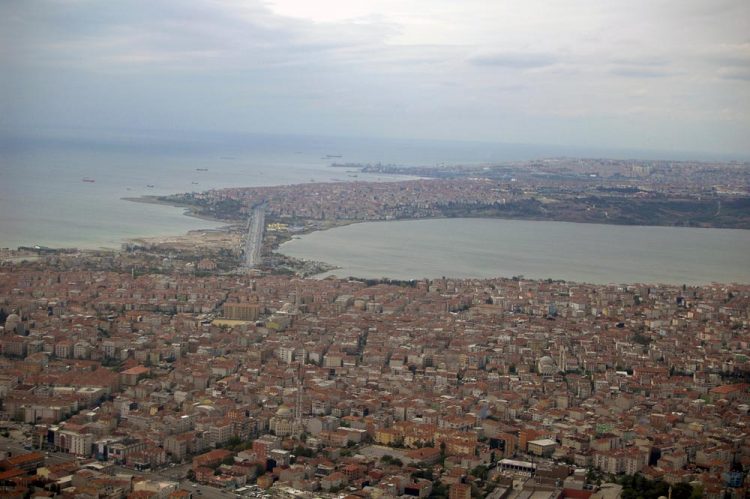The maximum earthquake magnitude for North Turkey

Aerial view of Western Istanbul. The western branch of the North Anatolian Fault Zone runs along the sea bottom of the Marmara Sea (left; photo: M. Bohnhoff, GFZ)
Geoscientists and natural disaster management experts are well aware of the risk prevailing in the megacity of Istanbul: The Istanbul metropolitan region faces a high probability for a large earthquake in the near future. The question is: how large can such an earthquake be?
Scientists from the GFZ German Research Centre for Geosciences together with a colleague from the University of Southern California have examined the earthquake maxima along the North Anatolian Fault Zone and came to the astonishing conclusion that mega quakes of magnitude M8 are exclusively to be expected in the east of this earthquake region. On the other hand the maximum earthquake magnitude to be expected in northwestern Turkey including the Istanbul-Marmara region does not exceed M7.5.
Seismologist, Marco Bohnhoff, from the GFZ explains: “We have compiled a new catalogue on historical seismicity for the North Anatolian Fault Zone (NAFZ) dating back to 300 years BC, thus, covering a time period of 2300 years. It is interesting to notice that in the North West of Turkey an earthquake with a magnitude larger than 7.5 has never been observed. On the other hand in eastern Turkey magnitudes of up to M8 are well documented.”
The observations can be explained by the age of the fault zone. The NAFZ extends through northern Turkey along more than 900 km from the northern Aegean Sea almost towards the Caucasus. The fault reflects the tectonic boundary between the Anatolian plate and the Eurasian plate in the North.
The Anatolian plate and with it the whole country of Turkey, moves towards the west and hereby interlocks with the Eurasian plate. The plate movement results in an accumulation of stress along the plate boundary that is released in large earthquakes with recurrence periods of several hundreds of years.
The just published new catalogue of historical earthquakes, together with further key parameters such as age, cumulative fault offset, slip rates and maximum length of coherent fault segments reveal a logical explanation.
Geoscientist Bohnhoff: “We were able to demonstrate that the smaller earthquake magnitudes in the west are closely linked to the earlier stage in fault-zone evolution there with an approx. age of eight million years. In comparison the eastern part of the NAFZ with an age of twelve to thirteen million years, is older and more mature. The largest M8 earthquakes solely occur along the older eastern part that also has longer consistent segments”.
This is due to the fact that continental transform faults such as the NAFZ have a life cycle. The rock does not fracture along the whole fault zone all at once but rather in sub-segments. In the run of millions of years some of these segments coalesce due to repeated activation during earthquakes.
Thus, due to the older age in the east these longer uniform sections are capable of generating larger ruptures and, therefore, larger earthquakes can be found in the east as compared to the west where the segments are still comparatively small and have not coalesced.
For Istanbul this implies that: Earthquakes as large as M8 are not expected there before further fault evolution that may take several millennia. This is important to estimate upper bounds for the seismic hazard and risk of the city.
This, however, by no means reduces the general seismic hazard for the metropolitan region since the NAFZ is located only 20 km away from the historic city center below the seafloor of the Marmara Sea where an up to M 7.5 earthquake can cause a great threat to the local population and infrastructure.
The results of the newly published study are relevant for the estimation of expected maximum magnitudes in highly populated regions, as well as for the determination of seismic hazards and the accompanying risks and, last but not least, they provide important baselines for adapting building codes.
Marco Bohnhoff, Patricia Martínez-Garzón, Fatih Bulut, Eva Stierle, Yehuda Ben-Zion: “Maximum earthquake magnitudes along different sections of the North Anatolian fault zone”, Tectonophysics, ++.03.2016, DOI: 10.1016/j.tecto.2016.02.028
http://www.sciencedirect.com/science/article/pii/S0040195116001256
Media Contact
All latest news from the category: Earth Sciences
Earth Sciences (also referred to as Geosciences), which deals with basic issues surrounding our planet, plays a vital role in the area of energy and raw materials supply.
Earth Sciences comprises subjects such as geology, geography, geological informatics, paleontology, mineralogy, petrography, crystallography, geophysics, geodesy, glaciology, cartography, photogrammetry, meteorology and seismology, early-warning systems, earthquake research and polar research.
Newest articles

NASA: Mystery of life’s handedness deepens
The mystery of why life uses molecules with specific orientations has deepened with a NASA-funded discovery that RNA — a key molecule thought to have potentially held the instructions for…

What are the effects of historic lithium mining on water quality?
Study reveals low levels of common contaminants but high levels of other elements in waters associated with an abandoned lithium mine. Lithium ore and mining waste from a historic lithium…

Quantum-inspired design boosts efficiency of heat-to-electricity conversion
Rice engineers take unconventional route to improving thermophotovoltaic systems. Researchers at Rice University have found a new way to improve a key element of thermophotovoltaic (TPV) systems, which convert heat…



